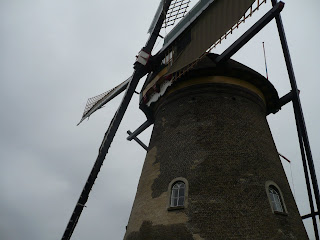Thursday, April 28, 2011
KINDERDIJK: WINDMILLS AND QUIXOTES
In Holland one major attraction is the row of windmills in Kinderdijk that still stands ready to pump water out of the fields and back into the river above. These structures are, when you are standing there looking at them, much larger than the imagination as guided by Cervantes. I was struck by their absolute gigantism. What occurred to me immediately is the question: “What was Don Quixote thinking when he dared to attack such a monster?”
First, let me mention that the Dutch government demands that all these old windmills be kept active and operated at regular intervals. The point is that they work and they do not need electricity or any other source of power except for the wind, which keeps coming intensely from the water. There are many other modern white windmills along the coast – indeed, an astonishing armada of windmills that must power many more things than the pumps that keep the waters at bay. It is a tribute to the Dutch willingness to tolerate despoiling the landscape for the sake of maintaining the overall ecology of their part of the planet. Keeping them operative is sensible, not just a bit of nostalgia for the past. They may be needed again.
Somehow, I hardly expected to see the windmill in action. I looked at the four blades of the fan and wondered how, since they were wood and see-through, they could function. Then, as I watched, a man responsible for the mill came out and climbed on a rack on the back of the windmill and began stomping on a machine that turned the blades into the wind. Then he drew sails down on two of the blades – opposite each other. And the fan began to move at an astounding rate. If he had put sails on all four blades, the speed would have been frightening. As it was, I could not be sure I could pass beneath the blades to see them from the other side. There are protective markers to keep us safe, but with that machine actually working and responding to the moisture and the brunt of the wind, you could see how much power was being captured by this extraordinary machine.
The age of the machine – dating to a time before Shakespeare, and with very little change up to the present – makes us aware of the independence and engineering skills of the Dutch long before modern tools made the building of such structures almost “easy.” These machines are guardians of a culture and a willingness to bring nature under some slight command. They are inspiring. And it would be quixotic to dismantle them.
Wednesday, April 20, 2011
REMBRANDT'S THE NIGHT WATCH
Fortunately, before we saw the painting we had a demonstration by a painter in the Rembrandthuis of how Rembrandt made his paints, using ground materials of lake and madder. Lake is a reference to colors of insect origins, such as the Laq bug and dried red worms. Madder refers to color substances that have vegetable origins. What interested me was the opportunity to participate in making a paint by grinding a substance, an earthen substance derived from stone, and then mixing it with linseed oil and walnut oil until it became one thing – not two things, such as oil and matter. Rembrandt seems to have depended on a pallette of 14 colors from which he then worked his canvases. All that was useful information for me standing before this huge painting if only because I could respond more deeply to the brilliance of the reds, the yellows, the silvers, and the rich dark colors that give the painting its name.
In a word, the vitality of the picture is what overpowers the viewer. The organization of the figures, including those who are partially hidden, is a work of genius which one appreciates after seeing some of the canvases of Rembrandt’s competitors. The Museum at Middleburg holds a half dozen giant group portraits that seem to have been very popular among the wealthy syndics of the 17th century, when the Dutch ruled the seas and had beaten the English into submission. But not one of them, despite the accuracy of their portraits, imparts a sense of life into the composition. Much the same can be said of group photographic portraits in our own time – all of which are lifeless and irrelevant except to those who are positioned centrally. In other words, most of the group portraits were pro forma, routine, and not really expected to be artistic, but simply to be a careful record of a collection of important figures. When we look at them now we respond cooly primarily because we know none of the players in the picture, and the picture is not in and of itself interesting as art.
Not so The Night Watch. We look at the painting and do not need to know who these men are. Indeed, when we do know, that knowledge does not really affect our aesthetic response to the painting. The beautiful girl to the left center was the mascot of the Watch and she bears a resemblance to Rembrandt’s Sabina, but to her right is a mysterious figure in battle gear running purposely away. All the figures seem to have a purpose and are in motion of one sort or another. Action conquers station in this painting, and it imparts a sense of significance missing from virtually all of Rembrandt’s competitors’ similar works.
Subscribe to:
Posts (Atom)



